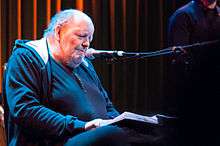Freddie Wadling
Berndt Arvid Freddie Wadling (2 August 1951 – 2 June 2016) was a Swedish singer and actor born in Gothenburg, whose over 30-year musical career extended from punk to classical ballads.[1]
Freddie Wadling | |
|---|---|
 Freddie Wadling performing at Bryggarsalen in Stockholm, Sweden, April 2011 | |
| Background information | |
| Birth name | Berndt Arvid Freddie Olsson |
| Born | 2 August 1951 Gothenburg, Sweden |
| Died | 2 June 2016 (aged 64) Västra Frölunda, Sweden |
| Genres | Rock, punk |
| Occupation(s) | Singer, songwriter |
| Years active | 1979–2016 |
| Associated acts | Liket Lever, Cortex, Straitjacket, Leather Nun, Blue for Two, Fleshquartet |
In various bands
He played bass in a number of bands during the 1970s and early 1980s. One notable band was Liket Lever (which translates as The Corpse Lives). In the early 1980s, he joined the cult band Cortex. During this period Cortex released the album Spinal Injuries in 1981. The song "The Freaks" sung by Freddie Wadling became a signature song for him and was used in the soundtrack of Tjenare Kungen. He also played in Straitjacket and Leather Nun. He also got attention with being part of the Fleshquartet.[2] Wadling was also featured in band Kingdom of Evol.
In Blue for Two
In the 1980s and 1990s, he was vocalist of the Swedish alternative pop/rock duo Blue for Two.[3] The duo started in Gothenburg in 1984 with him on vocals and Henryk Lipp as songwriter and on synthesizers. The band became one of the main bands in the Swedish alternative scene in the 1980s. They had a string of albums including Blue for Two (1986),[4] Songs from a Pale and Bitter Moon (1988), Search & Enjoy (1992), Earbound (1994) and Moments (1997). For their live performances, they were often accompanied by Sator guitarist Chips Kiesbye. Blue for Two made a comeback in 2012 and released the album Tune the Piano and Hand Me a Razor that reached No. 18 on the Swedish Albums Chart.
Solo career
Freddie Wadling developed a prosperous solo career, releasing a great number of albums, he recorded songs by John Dowland with the Forge Players in 1998, and very notably the highly acclaimed En skiva till kaffet (1999) and Jag är monstret (2005). The latter also contains collaborations with Thomas Öberg, Per Gessle and Tomas Andersson Wij. He also recorded some soundtracks with Magne Furuholmen and Kjetil Bjerkestrand.
He was awarded the Cornelis Vreeswijk Prize in 2005.
He released With a Licence to Kill featuring James Bond-songs in 2011 that reached No. 12 on the Swedish Albums Chart, and 2016 he released Efter Regnet that reached No. 7 on the Swedish Albums Chart.
Death
Freddie Wadling died on 2 June 2016 at the age of 64.[5][6] He died only a few days before he was due to travel to Gotland to participate in the TV4 show Så mycket bättre.
Discography
Albums
- In Cortex
- 1981: Spinal Injuries
- 1986: You can't kill the Boogeyman
- In Blue for Two
- 1986: Blue for Two
- 1988: Songs from a Pale and Bitter Moon
- 1992: Search & Enjoy
- 1994: Earbound
- 1997: Moments
- 2012: Tune the Piano and Hand Me a Razor
- With music project Mother
- 2008: LP (with music project Mother)
- Solo albums
- 1989: Something Wicked This Way Comes
- 1991: Picnic on a Frozen River (Collection album ft. Demos)
- 1991: The Dice Man (Collection album)
- 1997: A Soft-Hearted Killer Collection (Collection album)
- 1999: En skiva till kaffet
- 2000: Skillingtryck och mordballader
- 2005: Jag är monstret
- 2009: Den mörka blomman / The dark flower
- 2011: With a Licence to Kill (Reached No. 12 on the Swedish Albums Chart)
- 2016: Efter Regnet (Reached No. 7 on the Swedish Albums Chart)
- Featured in
- 2012: Dark Passages – Nocturnal Incidents (Kingdom of Evol feat. Freddie Wadling)
References
- "Freddie Wadling | Biography & History | AllMusic". AllMusic. Retrieved 9 November 2016.
- "Fläskkvartetten Featuring Freddie Wadling Med Västerås Symfoni 1:A* – Fläskkvartetten (CD, Album) at Discogs". discogs. Retrieved 9 November 2016.
- "Blue For Two Discography at Discogs". discogs. Retrieved 9 November 2016.
- "Blue for Two by Blue for Two (Album, Post-Punk): Reviews, Ratings, Credits, Song list – Rate Your Music". rateyourmusic.com. Retrieved 9 November 2016.
- "Freddie Wadling, Swedish singer and songwriter, Died at 64 | Obituary". deadfamous.info. Archived from the original on 11 September 2016. Retrieved 9 November 2016.
- "Freddie Wadling (1951 – 2016) RIP » Captain Beefheart Radar Station". beefheart.com. Retrieved 9 November 2016.
External links
- Freddie Wadling on IMDb
- Fansite (in Swedish)